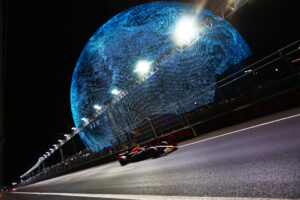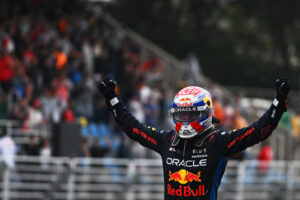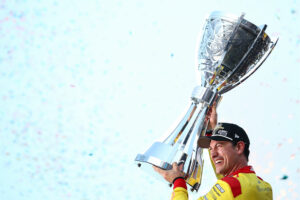Dan Wheldon was the driver that got me into IndyCar racing.
He was every where.I saw him on the side of the building when my family would take trips to the new Target that was built down the road from our house. I saw him gracing a full page ad for the IndyCar series in Sports Illustrated.
I don’t know why I chose him as my favorite driver, but it stuck, and I’m sure glad I did.
Dan Wheldon a Gambling Man in 2008 win at Iowa
IndyCar made its second trip to Iowa Speedway – a track 45 minutes from where I grew up – in 2008.
I really wanted to go to the race and probably would have if I wasn’t out of town playing hockey. Although the only memory I have of the race is seeing that Wheldon won on one of the parents’ phones, while we were at the hotel that night.
I legitimately don’t think I watched a lap of it, so that made for a great experience watching on Monday night.
I also had no idea that that would be his last win, excluding the Indy 500 in 2011.

The 2008 Iowa Corn Indy 250
Right before the running of the second IndyCar event at Iowa, towns and communities were amiss all over.
A statewide flooding issued had drastically effected a large portion of the state was at the forefront of the issues.
Almost all of Iowa’s 99 counties were effected by the flooding, however, the race went on as scheduled.
Before drivers could even report to their cars, Wheldon and his Chip Ganassi Racing team were already considered winners that day.
The England native and his team pledged that the winnings from that day’s race would be donated to Iowa Red Cross to aid the cities and people that fell victim to the floods.
Little did they know that it would be nearly $100,000.
Scott Dixon would lead the field to green. At that point in the year, he had led 633 laps in the series’ first eight races.
That was good for nearly half of the laps the series had run to date. No one was expecting Dixon to miss a podium finish. He had lived inside the top three that year.
Dixon started aside Helio Castroneves on the front row. The Penske Racing driver had earned eight straight top five’s to start the year, trying to compete with Dixon for the points championship, at the time.
Wheldon was behind them in third and veteran Tony Kanaan would launch from fourth.
Way back in the pack were the young likes of a pair of dominant drivers from today in Graham Rahal and Ryan Hunter-Reay, racing in some cars that were unfamiliar, at least to my young self, among a few other notable names.
Even though the pair of Chip Ganassi cars were starting in the first two rows, it became evident early on they wouldn’t be extremely dominant.
Almost immediately after the green flag flew, Castroneves went past Dixon.
By lap 4, Wheldon had been overtaken by Penske Racing’s Ryan Briscoe and Dixon had fallen to third at the hands of Kanaan.
It didn’t take long for me to catch another wave of nostalgia after that.

Kanaan was attempting to overtake Castroneves, but the high side of the track hadn’t come in yet.
The two drivers – who I grew up watching when I was first getting into IndyCar – raced side-by-side for eight laps.
That’s as vintage as it gets, for me.
It was considered such a normalcy that the ESPN broadcast still went to commercial in the middle of the battle.
Kanaan eventually overtook Castroneves on the outside, but if it hadn’t been for TK trying the top line, this race might have panned out differently.
A caution came out on lap 39 for Ed Carpenter, who’s suspension broke, putting his car into the wall.
The cars were running pace laps so quickly, that the restart didn’t occur until lap 52, which would play a big part late.
On the restart, Castroneves made it known that he had the car to beat on short runs, putting a lot of space between himself and Kanaan before the No. 11 car could make up any ground.
By the next caution and round of pit stops on lap 112, Kanaan had gotten to the rear of Castroneves again, but never went to the outside to attempt to overtake.

On pit road, a hiccup on the right-rear tire changing dropped Castroneves back to fourth. He had fallen behind Kanaan, Wheldon, and a surging Marco Andretti.
While Wheldon could keep his car solid enough to gradually move through the field, his aggressive driving style proved to be too big of a risk on the restart.
Wheldon tried going to the outside and dropped all the way back to ninth after getting a little loose. He had a lot of track position to make up in a race that was already short to begin with.
Meanwhile Andretti was making a charge to the front, passing Kanaan for the lead on lap 135. He’d hold the lead until the next caution flag, but would ultimately be shuffled out on pit lane.
The leaders came in to pits, but a few drivers elected to stay out. When the cars restarted, there would be 84 laps remaining. The fuel window was somewhere around 65 laps.
A trio of Dan Wheldon, Hideki Mutoh, and Danica Patrick were going to do all they could to stretch it.
It looked like a ballsy move at the time. If Wheldon’s car had been worse that day, I may have called it desperate. But he was running out of time to make something happen, and this was his best bet.
The three would get a couple more cautions, each one-car incidents, right off of the bat. It took the field up to lap 202 for another restart.
Wheldon had held his spot at the front, followed by Mutoh – a rookie at that point. Both were still going to be calling it close on fuel, but what was once a distant wish quickly became a reality.
With 39 laps remaining, Kanaan lost traction going into turns 1 and 2, turning his car rear-end-first into the wall.
The incident cleanup had the cars pace-lapping for 14 laps before the race restarted. Wheldon maintained the lead and would have to worry about one less threat to take the lead away from him.
Three laps out of the restart, Castroneves started falling off of the pace with concerns of a tire going down. He eventually came to pit road – another threat of Wheldon’s out of the way.
His teammate in Dixon had been near the front, and looked to make a closing move to go for yet another podium finish. However, he was steamrolled by a storming Andretti car.
Marco – on fresh tires – was going to have a shot to win.
With 20 laps to go, Mutoh was the only thing standing between Dan Wheldon and Andretti. The only issue was the rookie in Mutoh.
There were no team orders. There was no courtesy given up. Mutoh was going to make Andretti earn it if he was going to let him by to challenge Wheldon.
Mutoh rode the draft of the No. 10 perfectly and protected the inside. Andretti tried and tried, but wasn’t going to hit pay dirt.

Andretti, running out of time with less than 10 laps to go, went down low on Mutoh, but the No. 27 car slammed on the door on its teammate and held his ground.
Wheldon just rode his way to his second win of the year.
The 30-year-old, on his birthday nonetheless, was overcome with joy in victory lane. He was happy enough to kiss ESPN’s Jack Arute on the forehead after doing his interview.
That’s just the type of person – at the core – that Wheldon was.
It was abnormal to see him without a smile on his face.
Wheldon never got too serious and he approached his challenges with optimism…
And after watching those 250 laps for the first time, I think those are a few core reasons of why I grew up cheering for the guy they called Lionheart. It was surreal to see him win something again.
For more stories from our Racing Re-Watch series, visit our central hub, where we have each of the others that we’ve pushed out since the start of the COVID-19 shut down period.






